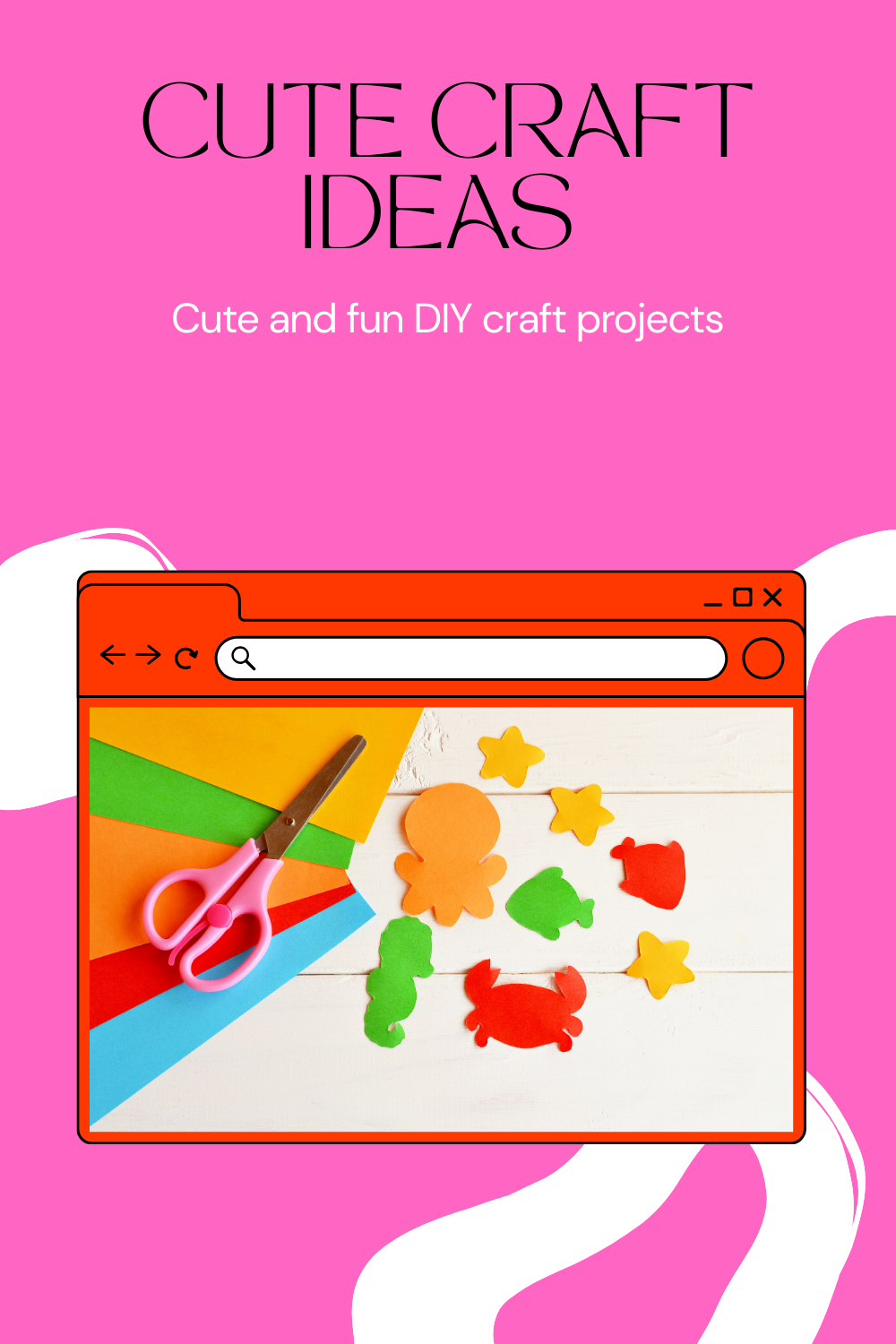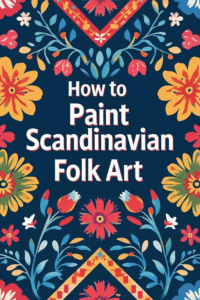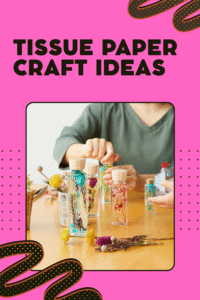Faux Stained Glass with Tissue Paper
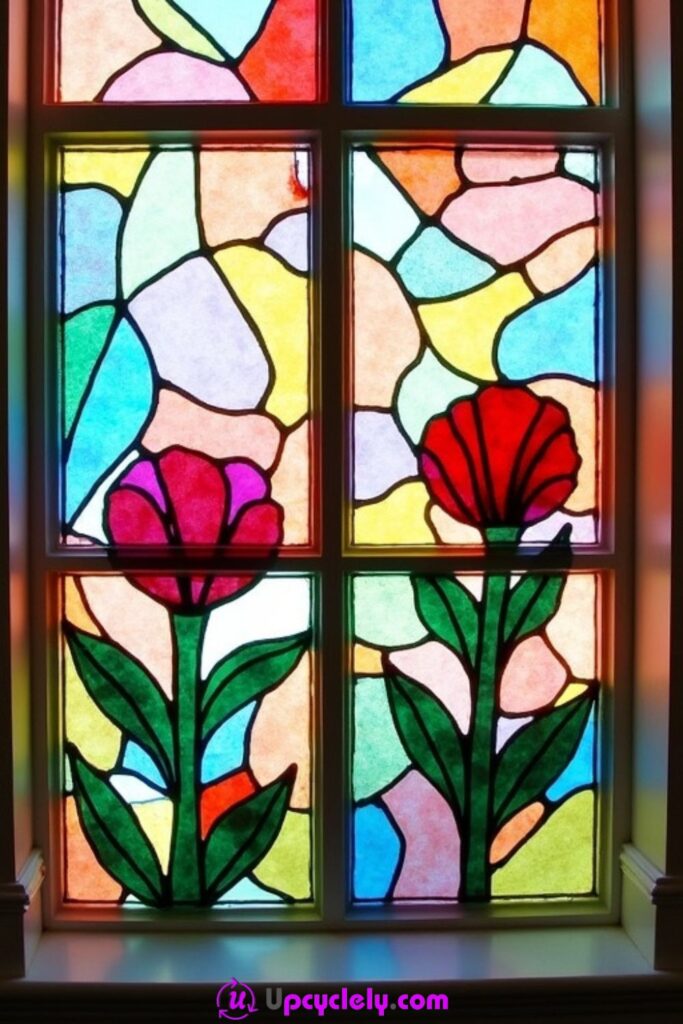
Materials you’ll need:
- A plain picture frame (remove the backing)
- Clear transparency film or glass from the frame
- Tissue paper in assorted colors
- Black adhesive lead strips or black craft tape
- Craft glue
- Scissors
- Paintbrush
Steps to Create:
Step 1: Start by preparing your frame. I take out the glass sheet or transparency film and clean it thoroughly to make sure there’s no dust. Lay it flat on your workspace.
Step 2: Cut tissue paper into different shapes and sizes, like triangles, squares, and irregular pieces. This will give your craft that classic mosaic stained glass vibe.
Step 3: Use craft glue to attach the tissue paper pieces onto the glass or film. I like to play with color combinations, layering slightly overlapping pieces for a blended look. Use a paintbrush to smooth out air bubbles as you stick the pieces down.
Step 4: To mimic the leading in stained glass, add black tape or adhesive lead strips over the tissue paper edges. Outline shapes to make them pop, and trim any excess. Once dry, reinsert the glass into the frame.
Pro Tip:
Use brighter tissue paper colors for sunlight-facing windows. The way light shines through the finished piece is absolutely magical!
Button Art Wall Hanging
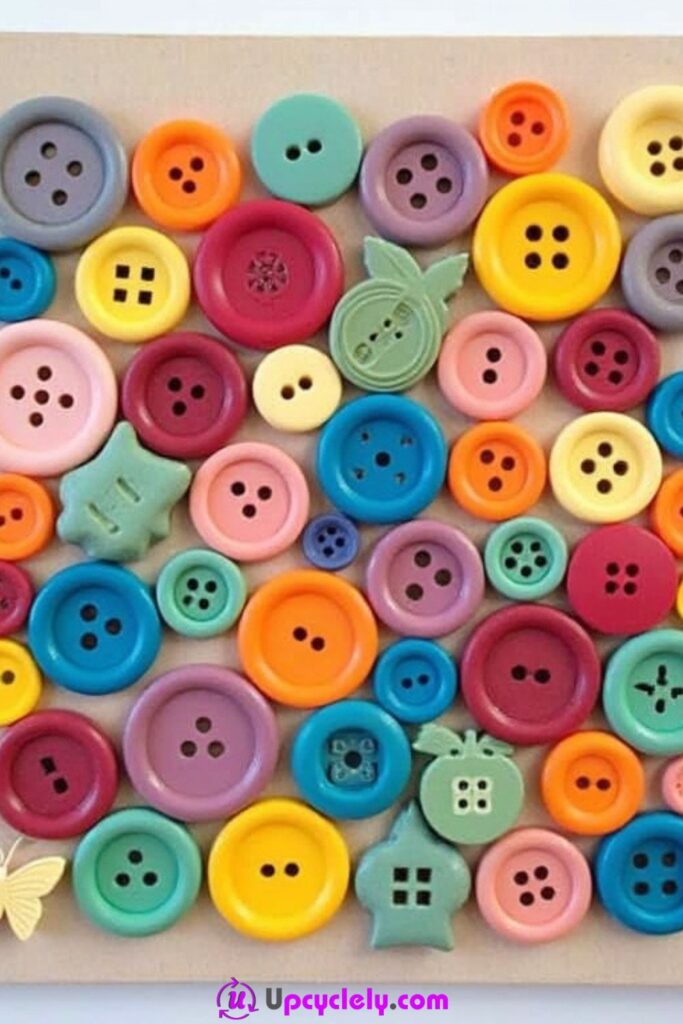
Materials You’ll Need:
- A sturdy square canvas or foam board
- A variety of buttons in shapes and colors
- Hot glue gun and glue sticks
- Pencil
- Ruler
Steps to Create:
Step 1: Begin by outlining your design on the canvas using a pencil. I like creating abstract shapes or cute outlines like hearts or stars.
Step 2: Arrange buttons of various sizes and colors over your design. Play around with placement before gluing to make sure the colors flow seamlessly.
Step 3: Once you’re happy with the arrangement, start gluing the buttons one by one using a hot glue gun. Use smaller buttons to fill in gaps between larger ones.
Step 4: Add an extra decorative touch by placing a feature button, such as a star-shaped one, as a focal point. I sometimes add a little butterfly design in the corner for a pop of whimsy.
Pro Tip:
If you’re working with smaller buttons, using tweezers helps ensure precision and keeps your fingers glue-free.
Button Embellished Pillow
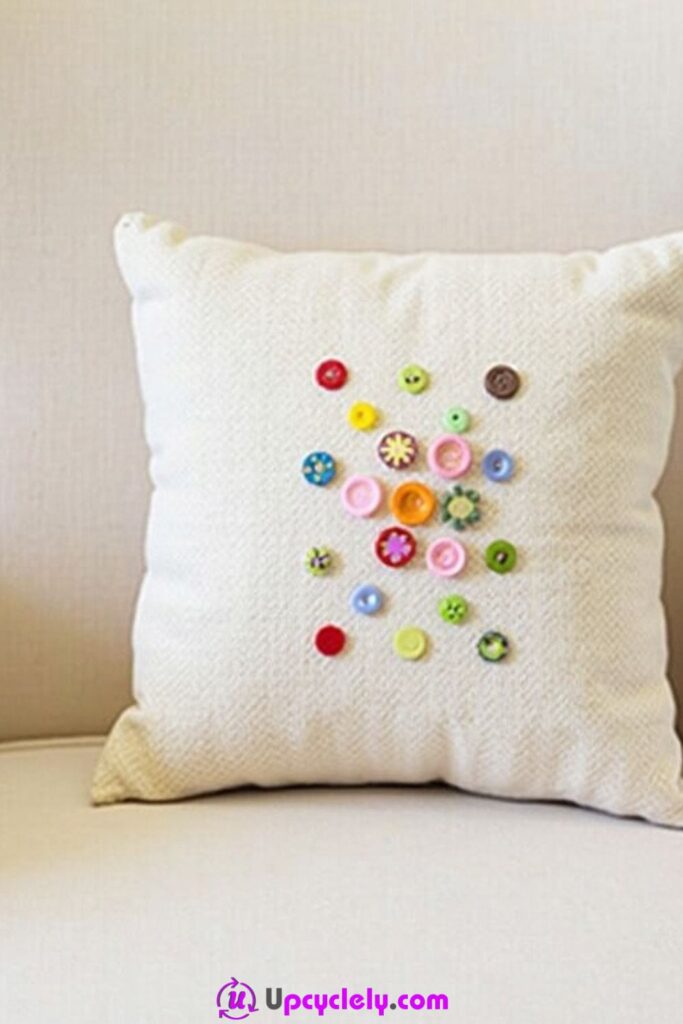
Materials You’ll Need:
- A plain throw pillow (light-colored fabric works best)
- A mix of buttons in various colors, sizes, and patterns
- Strong fabric glue or a needle and thread
- Ruler
- Chalk or fabric marker
Steps to Create:
Step 1: Spread out your pillow and decide where you want the buttons to go. I often cluster them in the center or create simple patterns like a flower or heart. Use a chalk or fabric marker to lightly trace your design.
Step 2: Attach buttons using fabric glue, starting at one end and working your way across. If you’re more patient than me, you can sew each button on for extra durability.
Step 3: Add some contrast with buttons of different textures. For example, I love sneaking in a few metallic or floral-patterned buttons to add charm.
Step 4: Once everything is firmly secured, allow your pillow to dry flat for at least 24 hours before placing it on furniture.
Pro Tip:
Stick to a similar color palette for the majority of your buttons, but include a few bold accents for visual excitement.
Cupcake Liner Flowers
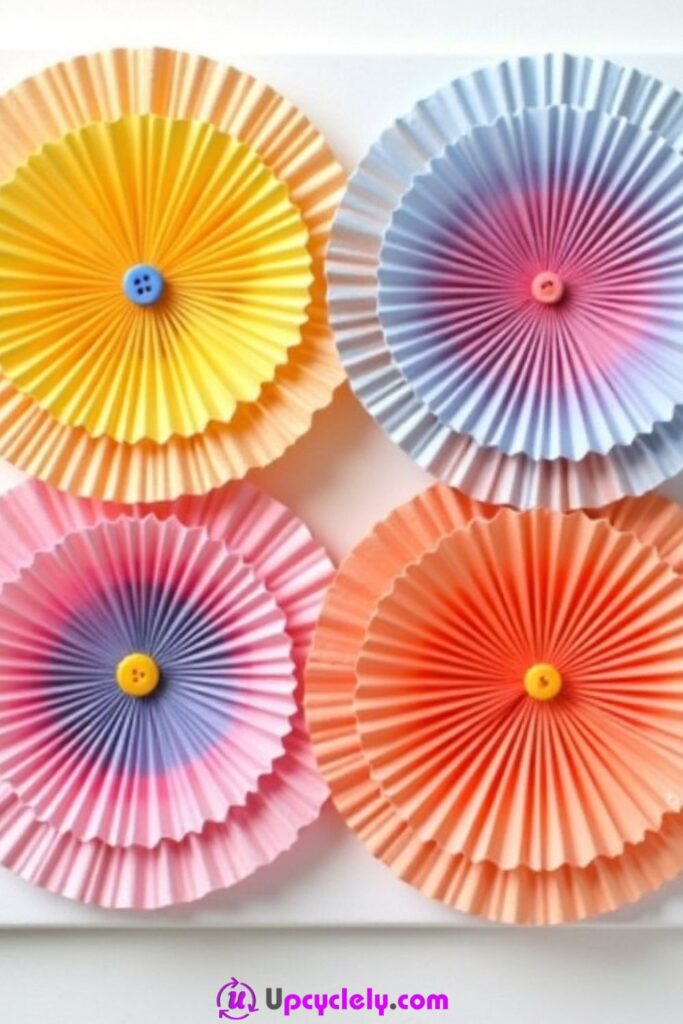
Materials You’ll Need:
- Cupcake liners in assorted colors and patterns
- Buttons
- Hot glue gun
- Scissors
- Cardstock or foam board (for backing)
Steps to Create:
Step 1: Flatten your cupcake liners and stack two or three on top of each other. I alternate colors to make the flower petals stand out.
Step 2: Cut small slits from the edge toward the center. Be careful not to cut all the way through! This creates the pleated edges of the petals.
Step 3: Glue a button in the center of the stacked cupcake liners, securing them all together. I like to use bright-colored buttons for a cheerful touch.
Step 4: Mount your flowers on cardstock or foam board for a sturdy base. Arrange them in a grid or scattered pattern.
Pro Tip:
Lightly curl the edges of the cupcake liners outward with a pencil for a more realistic, 3D flower effect.
DIY Pom-Pom Animals with Felt Ears
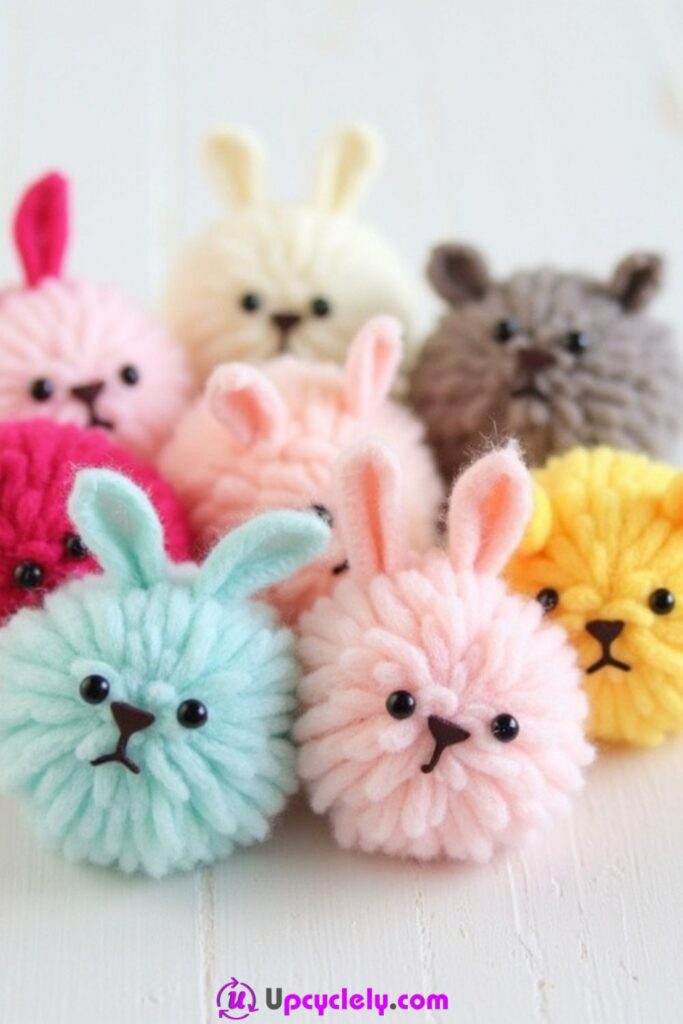
Materials You’ll Need:
- Yarn in bright pastel colors
- Felt sheets (white, black, pink, etc.)
- Black beads or googly eyes
- Scissors
- Hot glue gun
- Pom-pom maker or cardboard template
Steps to Create:
Step 1: Make your pom-poms using yarn. I wrap yarn around a pom-pom maker or two pieces of cardboard until it’s thick. Cut around the edges and tie the center tightly before trimming to shape.
Step 2: Cut felt into ear shapes. For bunnies, I cut long ovals, and for bears, small rounded triangles work best.
Step 3: Glue the felt ears onto the top of each pom-pom. It’s easiest to work with the hot glue gun here since it adheres quickly.
Step 4: Add black beads for eyes and a small stitch or dab of paint to make the mouth. I sometimes use tiny felt circles to make little noses.
Pro Tip:
Mix yarn textures (like fuzzy and smooth) to create unique animals. It adds depth and character to each little creature.
Mini Macramé Plant Hangers for Tiny Planters
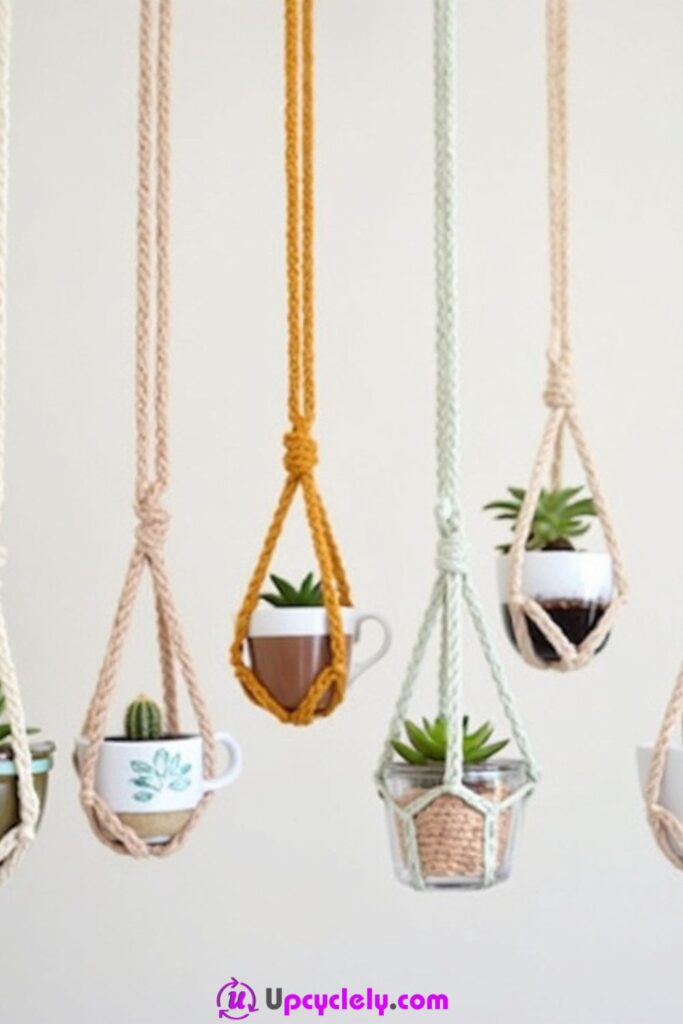
Materials You’ll Need:
- Cotton rope (varied colors like beige, pink, or green)
- Tiny planters or cups
- Scissors
- Ruler
- Metal or wooden ring
Steps to Create:
Step 1: First, I measure and cut pieces of rope to the desired length. For a tiny planter, I typically cut eight pieces each about 20 inches long. Once cut, I gather all the pieces and thread them through a wooden or metal ring, pulling evenly so the ring sits at the rope’s center.
Step 2: Next, I tie a large knot just below the ring to secure all the ropes together. This acts as the hanger base. Then, I divide the ropes into pairs and tie small knots a few inches below the main knot, forming loops for holding the planter.
Step 3: To create a net-like cradle for the planter, I take one rope from each pair and knot it with the rope from the adjacent pair. This forms a diamond-shaped pattern. I adjust the spacing carefully, depending on the size of my planter.
Step 4: Once the cradle is complete, I slide the planter into the ropes, ensuring it’s snug and supported. I tie all the strands together at the base of the planter for added security and trim the ends to the same length for a neat finish.
Pro Tip:
For an extra touch, thread a few colorful beads onto the ropes before tying the knots for a playful and decorative look.
Feather and Bead Mobile

Materials You’ll Need:
- Feathers (assorted sizes and colors like white, brown, and gray)
- Colorful beads
- Light string or thread
- Wooden hoop
- Scissors
- Glue (optional)
Steps to Create:
Step 1: I start by cutting multiple lengths of string, ensuring each piece is long enough to hang from the hoop and accommodate the beads and feathers. I tie the strings to the wooden hoop, spacing them evenly around the circle.
Step 2: On each string, I thread beads of different sizes and colors, tying small knots to hold them in place. I love experimenting with patterns, such as alternating vibrant and neutral tones, for a lively yet balanced look.
Step 3: Below the beads on each string, I attach a feather. I prefer tying a small knot to secure the feather, but glue can also work for a tighter hold. Feather lengths and colors can differ to add dynamic visual interest.
Step 4: Finally, I add three additional strings of equal length to the top of the hoop and tie a knot at the top to create a loop for hanging. Once secured, I adjust and fluff out the feathers to ensure they hang neatly.
Pro Tip:
Sprinkle a bit of glitter on the feathers for a shimmering, ethereal effect, especially if you’re hanging the mobile near soft lighting.
Kawaii Polymer Clay Food Charms
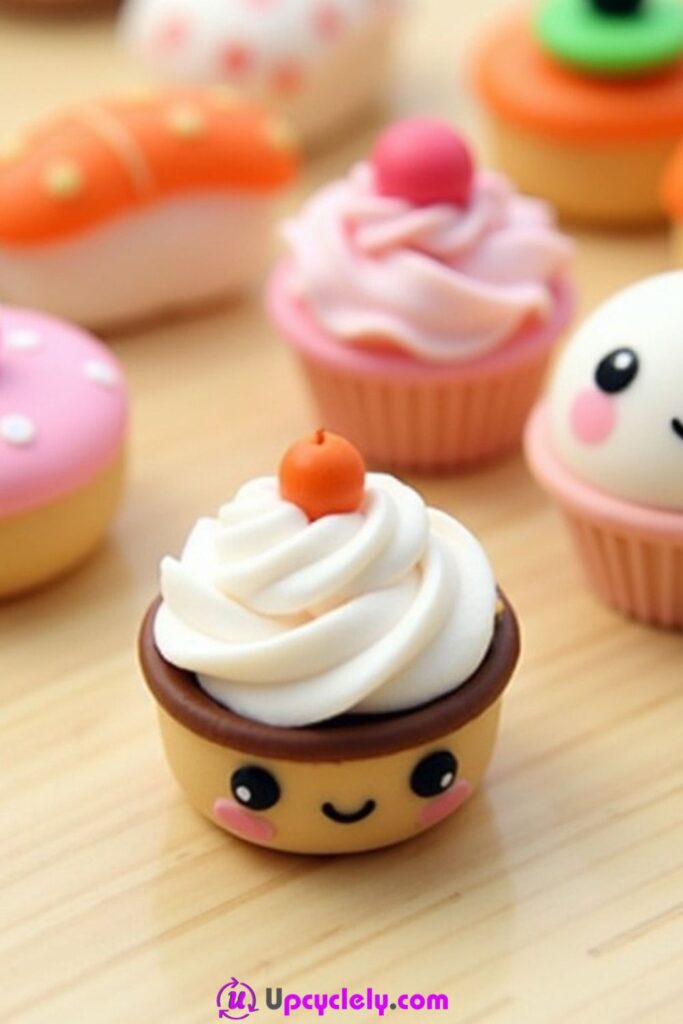
Materials You’ll Need:
- Polymer clay (in pastel and bright colors)
- Clay tools or toothpicks
- Eye pins or jump rings
- Clear glaze or sealer
- Baking tray (specific for crafting, not kitchen use)
Steps to Create:
Step 1: I begin by shaping the polymer clay into miniature food items. For a cupcake, I form two parts: the base as a small cylinder and the top as a swirled dome. I also add tiny details like sprinkles or a cherry on top to make it extra cute.
Step 2: Using a toothpick or clay tool, I gently imprint textures and designs. For the cupcake, this step includes adding ridges to the base and swirling the frosting for a realistic effect. Faces can be illustrated with tiny clay pieces.
Step 3: Once I’m happy with the design, I insert an eye pin into each charm before baking. This ensures the charm can be attached to chains or keyrings later. Then, I bake the clay items according to the package instructions.
Step 4: After the clay pieces cool, I apply a layer of clear glaze to add shine and protect the surface. Once the glaze is dry, I attach jump rings to the eye pins, turning the charms into adorable accessories.
Pro Tip:
Mix and swirl two clay colors together for a marbled effect, making your charms stand out even more.
LED String Light Garland with Paper Flowers
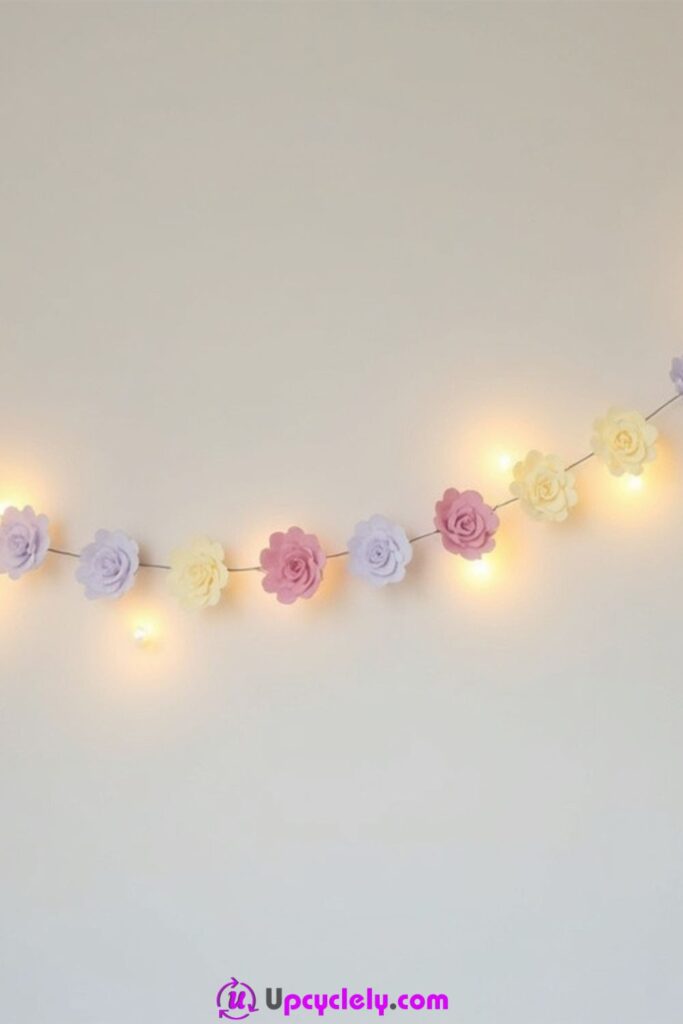
Materials You’ll Need:
- LED string lights
- Colored craft paper
- Scissors
- Pencil
- Hot glue gun
Steps to Create:
Step 1: I start by cutting flower shapes out of the craft paper. To add dimension, I cut layers in different sizes and curl the petals slightly with a pencil, giving each flower a natural look.
Step 2: Next, I take an LED light on the string and thread it through the center of a flower. I secure the flower around the base of the light with hot glue, ensuring it stays in place while still allowing the light to shine through.
Step 3: I continue this for each light on the string, alternating flower colors to create a pattern. I like to use coordinating pastel shades like pink, yellow, and purple, which glow beautifully when lit.
Step 4: Once all the flowers are attached, I hang the garland in my chosen space, such as along a wall or across a window. Seeing it light up is always so satisfying!
Pro Tip:
Use lightweight vellum paper instead of regular craft paper for a translucent effect that enhances the glow of the lights.
Mini Felt Pouches
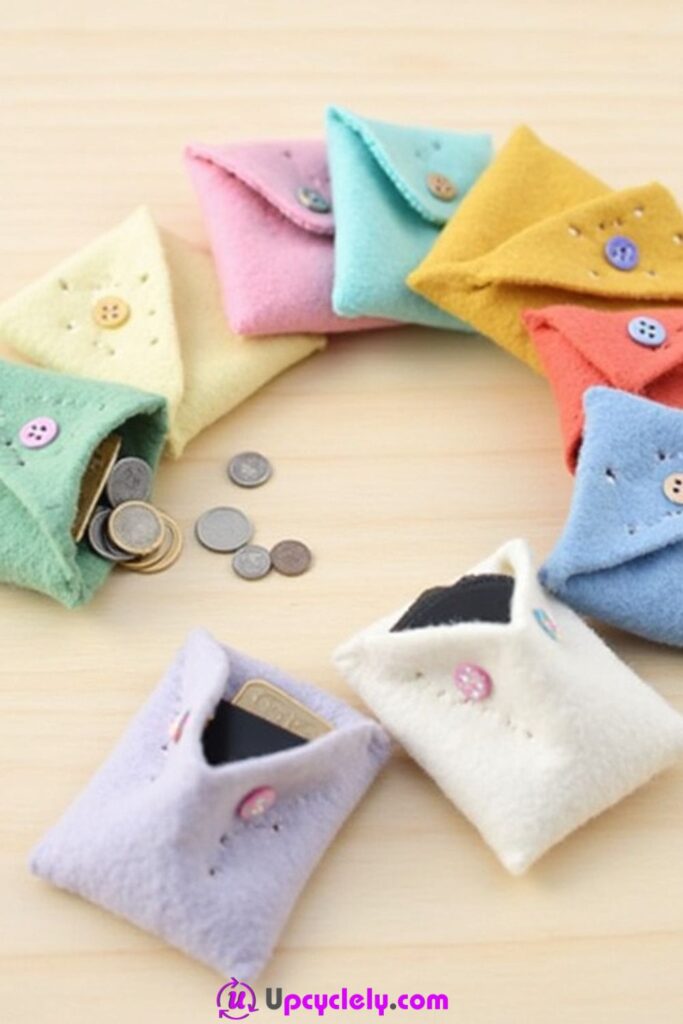
Materials You’ll Need:
- Felt sheets (variety of colors)
- Needle and thread or fabric glue
- Buttons for closures
- Scissors
- Ruler
Steps to Create:
Step 1: I begin by cutting out rectangles from the felt sheets. Each rectangle should be twice the height of the desired pouch, plus an additional inch for the flap. I fold the felt in half, leaving a portion at the top for the flap.
Step 2: I sew or glue the sides of the folded felt, leaving the top open. A simple running stitch works perfectly, but glue is quicker if sewing isn’t your thing. Make sure to leave the flap free from adhesion.
Step 3: To create the closure, I attach a button to the front of the pouch and cut a small slit in the flap to secure it. I like using buttons that complement the felt color for a cohesive look.
Step 4: Finally, I decorate the pouch with fun embellishments like embroidery, felt shapes, or even tiny beads. This step adds personality and charm to each piece.
Pro Tip: Create a matching set with different felt colors and motifs to gift as personalized presents or use as organizers for small items like buttons or jewelry.
Scrapbook Paper Wall Art
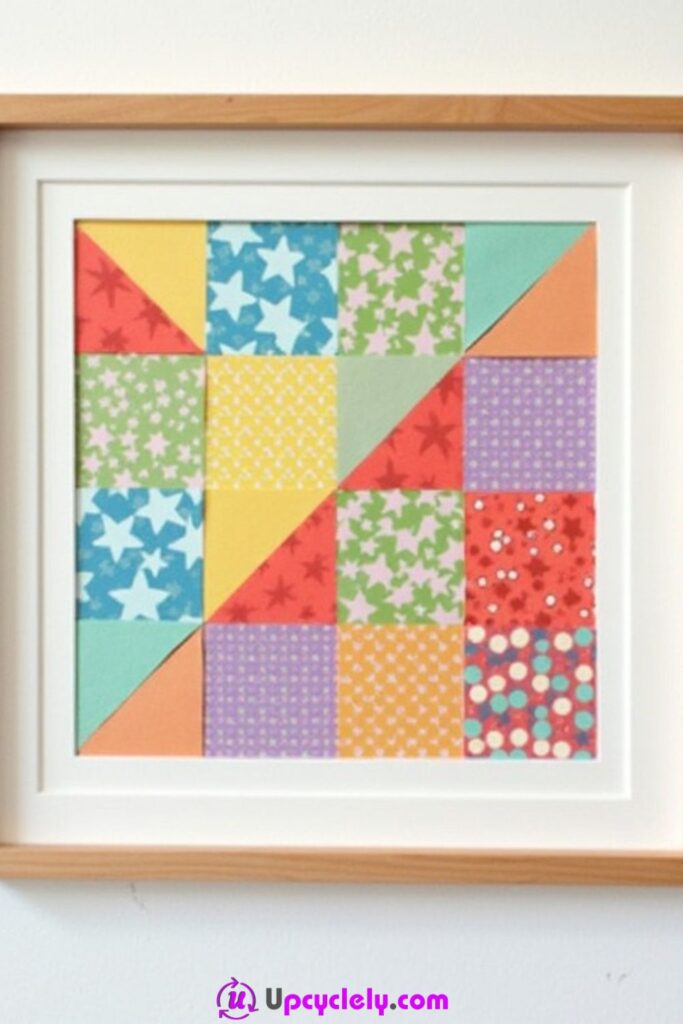
Materials You’ll Need:
- Scrapbook paper with assorted patterns and colors
- A square frame (glass or without glass)
- Scissors or a craft knife
- Ruler
- Glue stick or double-sided tape
Steps to Create:
Step 1: To start, I choose scrapbook paper in complementary colors and patterns. I envision the patterns arranged in a 4×4 grid, so I cut 16 squares of equal size using a ruler and scissors. Each square measures about 3 inches per side, but you can adjust the size depending on your frame.
Step 2: I decide on a layout, mixing bolder patterns with softer ones so the design looks balanced. I arrange them on the frame backing to test how they look together before gluing anything down.
Step 3: Once I’m pleased with the arrangement, I use a glue stick or double-sided tape to neatly attach each square to the backing. I carefully position them, ensuring even spacing between all the squares.
Step 4: After the glue dries, I place the backing into the frame. If your frame doesn’t have glass, the texture of the patterned paper will stand out beautifully. Finally, I hang it on the wall to add a pop of color to the space.
Pro Tip:
If you want extra texture, layer shapes like stars or hearts on top of the squares before gluing them on. It adds a three-dimensional touch and enhances the visual appeal.
Painted Wooden Spoons
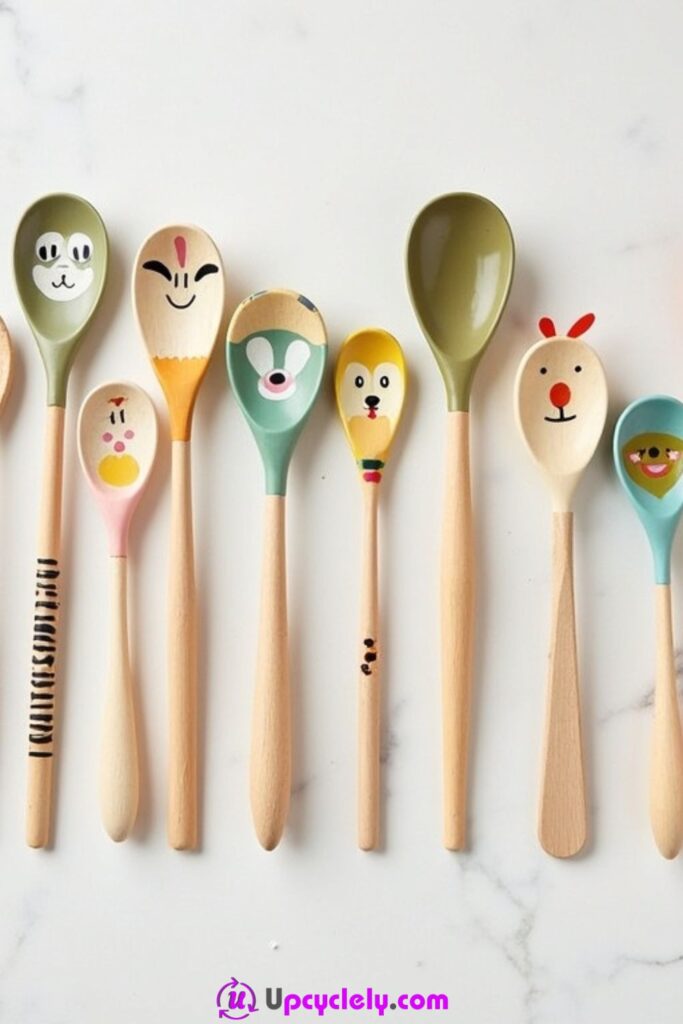
Materials You’ll Need:
- Wooden spoons (plain and clean)
- Acrylic paints in assorted colors
- Paintbrushes
- Painter’s tape
- Clear food-safe sealant
Steps to Create:
Step 1: I first prepare the spoon surface by ensuring it’s smooth and clean. For designs that involve unpainted sections, I use painter’s tape to mask off areas to keep the wood showing.
Step 2: I plan fun designs for each spoon. For example, I might paint a panda face on one and a smiling cat on another. Using acrylic paints, I apply the base color on the spoon handle or bowl, then allow it to dry fully.
Step 3: I go in with smaller brushes to paint detailed designs like eyes, noses, or stripes. If layering multiple colors, I make sure each layer is completely dry before adding the next one.
Step 4: Once all my designs are done, I apply a clear food-safe sealant over the painted areas. This keeps the paint intact, even with occasional use or washing. After the sealant dries, my decorative spoons are ready!
Pro Tip: Use a fine-tip brush and a steady hand for intricate designs. Practice drawing your patterns on paper first to perfect them before painting.
Popsicle Stick Picture Frames
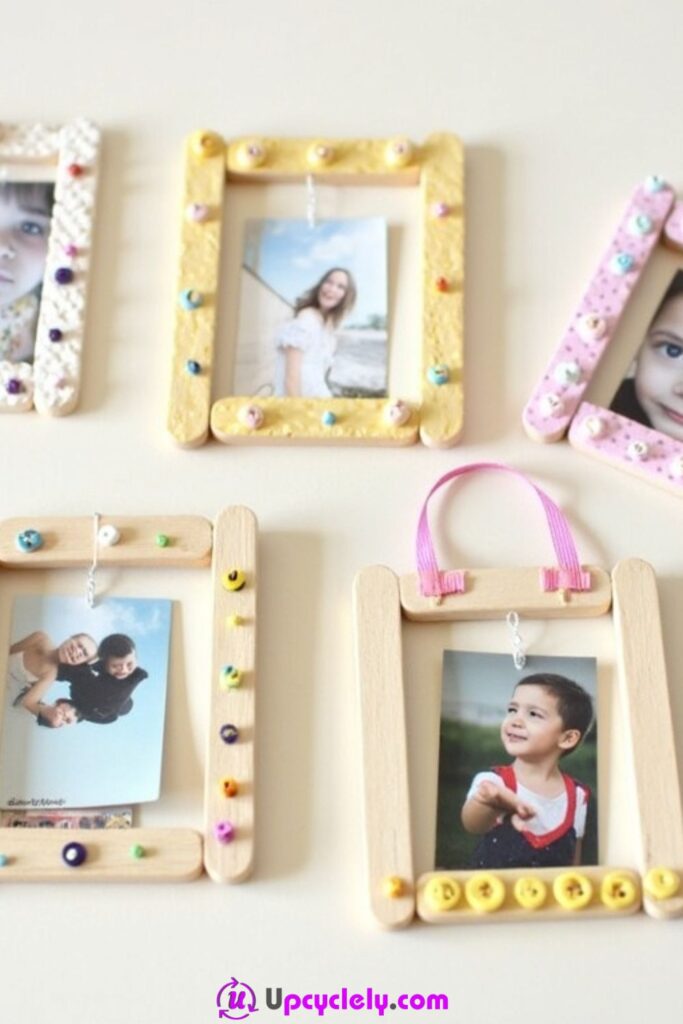
Materials You’ll Need:
- Popsicle sticks
- Paint or markers
- Glue (hot glue or craft glue)
- Beads, ribbons, or stickers for decoration
- Small photos
- Cardboard backing
Steps to Create:
Step 1: I begin by creating the frame shape. For a basic square frame, I glue two popsicle sticks horizontally and then two vertically on top to form a simple square structure. For added strength, I use hot glue.
Step 2: Next, I paint the frame in vibrant colors or patterns. I love blending colors or creating stripes for a cheerful and personalized look. Once the paint dries, I add decorative elements like beads or stickers to make each frame unique.
Step 3: I cut a piece of cardboard slightly smaller than the frame’s inner dimensions and glue it to the back as a sturdy surface. The cardboard will support the photo.
Step 4: I attach a small photo to the cardboard with glue or tape, ensuring it’s centered. If I want to hang the frame, I glue a small loop of ribbon to the top for easy wall hanging.
Pro Tip:
Create a set of these frames with different themes or colors for a coordinated but playful gallery wall.
Ribbon Flowers
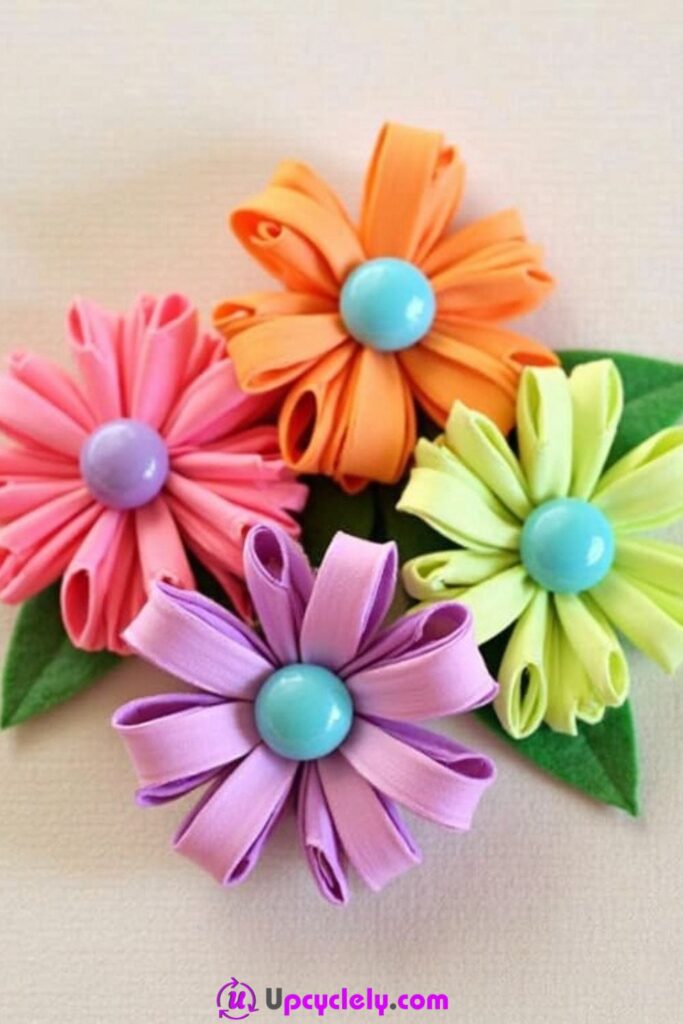
Materials You’ll Need:
- Satin or grosgrain ribbon in assorted colors
- Small buttons (for flower centers)
- Hot glue gun
- Scissors
Steps to Create:
Step 1: To make a flower, I cut strips of ribbon, each about 6 inches long. For fuller flowers, I use more strips. I fold each strip in half, forming a loop, and secure the ends together with a dab of hot glue.
Step 2: I arrange the glued loops in a circular pattern to form petals, gluing them at their base. I ensure the loops overlap slightly for a natural look.
Step 3: Once the petals are in place, I glue a button in the center. The button adds character and secures the petals firmly together.
Step 4: To complete the flower, I cut a small circle of felt and glue it to the back, covering any messy glue marks and adding stability. These flowers make great embellishments for gifts or hair accessories!
Pro Tip:
Choose ribbons with varying textures or patterns to create flowers with a dynamic and eye-catching appearance.
Rope and Fabric Wall Hanging
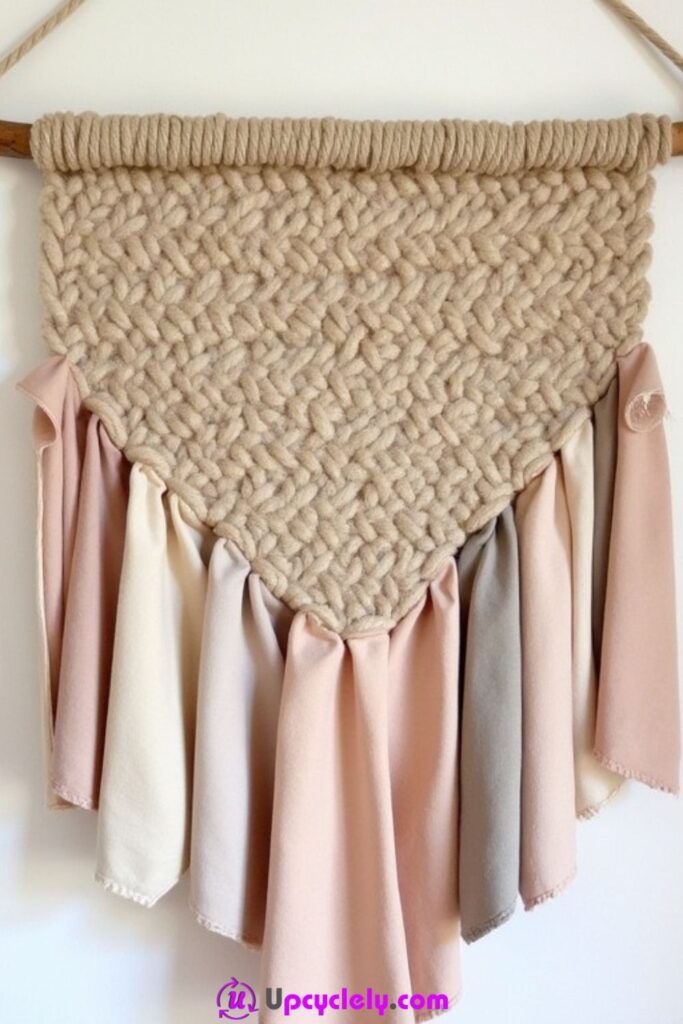
Materials You’ll Need:
- Thick macramé rope or yarn
- Strips of fabric in assorted colors
- Wooden dowel or branch
- Scissors
Steps to Create:
Step 1: I start by folding my rope into a triangular woven pattern. I knot each strand securely onto a wooden dowel. For beginners, a simple knotting design works well, but you can experiment with different macramé patterns for a unique look.
Step 2: I cut long strips of fabric in coordinating colors like beige, cream, and soft pink. You can vary the widths for more texture. I then tie the strips to the bottom edge of the woven section, letting them drape downward.
Step 3: To add layers, I tie shorter fabric strips to the base of some ropes. This creates depth and gives the hanging a fuller, more dynamic appearance.
Step 4: I finish by trimming the ends of the fabric to make them even or shaping them into a V or zigzag pattern. After attaching a hanging rope to the dowel, my wall decor is complete and ready to display!
Pro Tip:
Mix in metallic ribbon or lace with the fabric strips to give your wall hanging a subtle sparkle and an elevated look.
Tiny Terrarium Necklaces
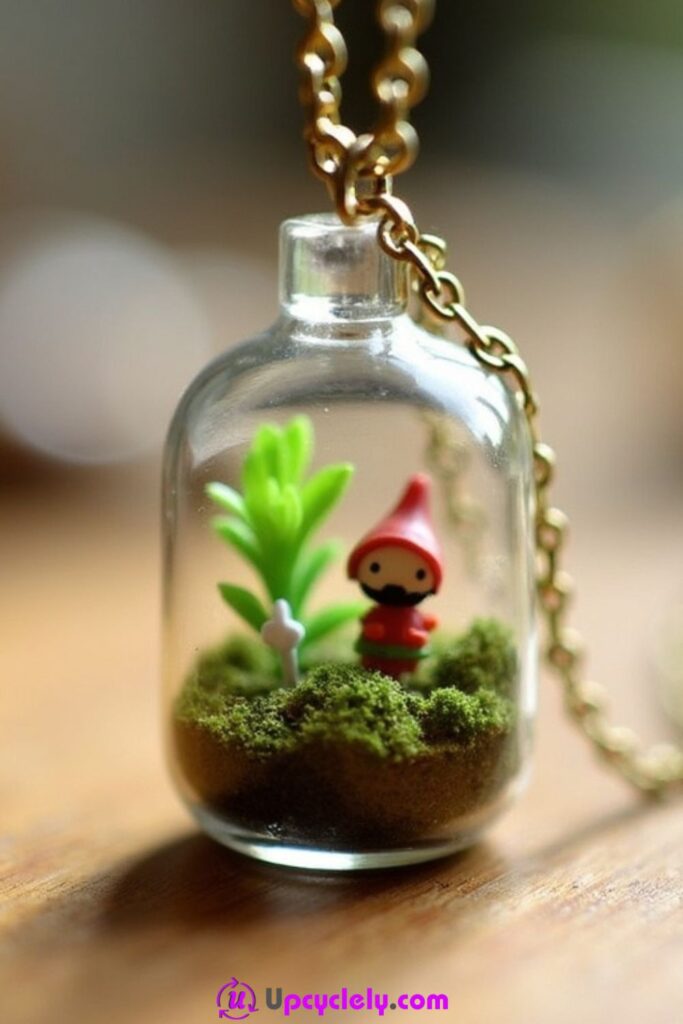
Materials You’ll Need:
- Small glass bottles with cork stoppers
- Chain necklaces or leather cords
- Dried moss or miniature artificial moss
- Miniature decorations (like tiny figurines or faux plants)
- Tweezers
- Hot glue gun
Steps to Create:
Step 1: I begin by preparing the materials. I cut a small amount of dried or faux moss to fill the bottom of the tiny glass bottle. Using tweezers, I carefully place the moss inside, arranging it to create a soft, cushy base.
Step 2: Next, I choose a miniature decoration for the terrarium. Tiny figurines, mushrooms, or even a fairy-like object work perfectly. Using the tweezers, I gently position the decoration on top of the moss, ensuring it’s upright and centered.
Step 3: To secure the cork stopper, I apply a small dot of hot glue around the edge of the bottle’s neck before pressing the cork in firmly. This step ensures that the contents won’t shift or spill.
Step 4: Finally, I attach the bottle to the chain necklace or leather cord. Most bottles have a small metal loop on the cork for hanging; if yours doesn’t, hot glue a small metal ring to the top. Once everything is secure, my whimsical necklace is ready to wear.
Pro Tip:
Add tiny crystals, glitter, or colored sand to the moss for a magical, enchanted forest vibe.
Seashell Wall Hanging
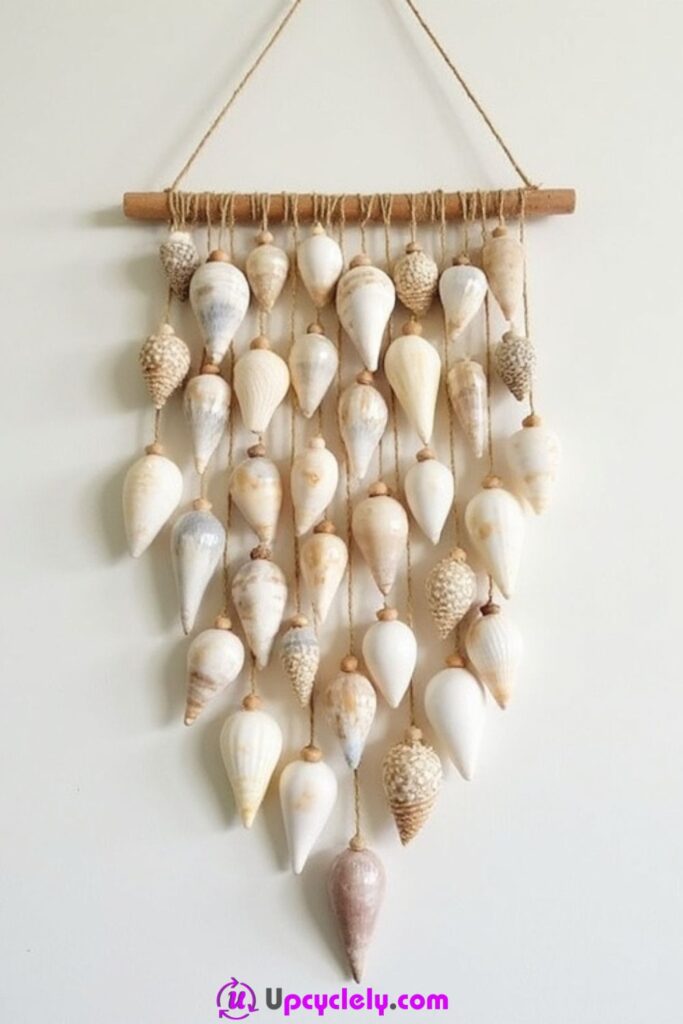
Materials You’ll Need:
- A horizontal wooden rod or dowel
- Natural twine or cotton string
- Assorted seashells with pre-drilled holes
- Wooden beads (optional)
- Scissors
Steps to Create:
Step 1: I start by laying out my design. I choose an assortment of seashells and arrange them in vertical rows, placing larger shells toward the bottom and smaller ones near the top. This creates a visually balanced look.
Step 2: I cut several pieces of twine, each the desired length of the hanging. I tie one end of the twine firmly to the wooden rod, leaving even spacing between each strand.
Step 3: To attach the shells, I thread the twine through the pre-drilled holes in each shell, tying knots to secure them in place. Sometimes, I add wooden beads between shells for a decorative touch.
Step 4: After all the strands are complete, I tie a length of twine to both ends of the rod to act as a hanger. Once the wall hanging is complete, I fluff out the strands and adjust them as needed before hanging it up for display.
Pro Tip:
Use a mix of glossy and matte seashells, or paint a few in pastel shades for a chic, coastal look.
Stamped Wooden Coasters
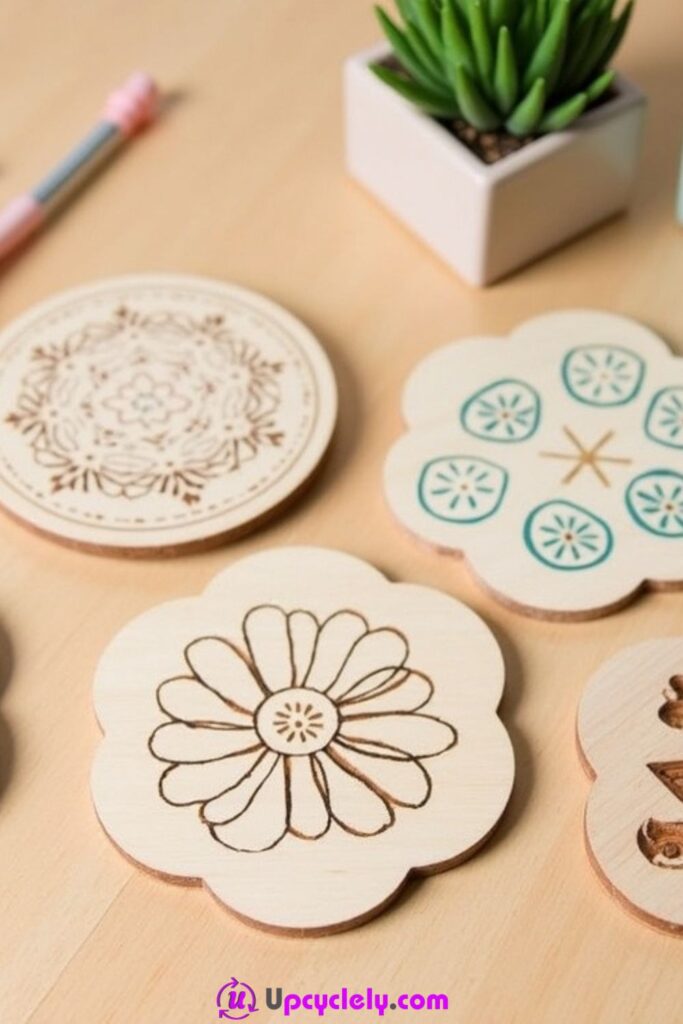
Materials You’ll Need:
- Plain wooden coasters
- Rubber stamps with decorative designs
- Waterproof ink pads (in assorted colors)
- Clear varnish or wood sealant
- Paintbrush
Steps to Create:
Step 1: To begin, I make sure the wooden coasters have a smooth surface. If necessary, I lightly sand them to create a better surface for stamping. Wipe away any dust so they’re clean and ready to decorate.
Step 2: I select rubber stamps with beautiful patterns. Floral designs, geometric shapes, or even custom-made stamps can work. Dipping the stamp in an ink pad, I firmly press it onto the coaster. If I’m using multiple colors or overlapping designs, I allow one layer of ink to dry before adding the next.
Step 3: Once all the coasters are stamped and dried, I use a soft paintbrush to apply a layer of clear varnish or wood sealant. This protects the stamped designs from wear and makes the coasters waterproof.
Step 4: After the varnish has dried completely, I test the coasters by placing a water-filled glass on top. They’re ready to use or be gifted as a thoughtful handmade present!
Pro Tip:
Experiment with embossing powder on the ink for raised, textured designs that are both eye-catching and durable.

